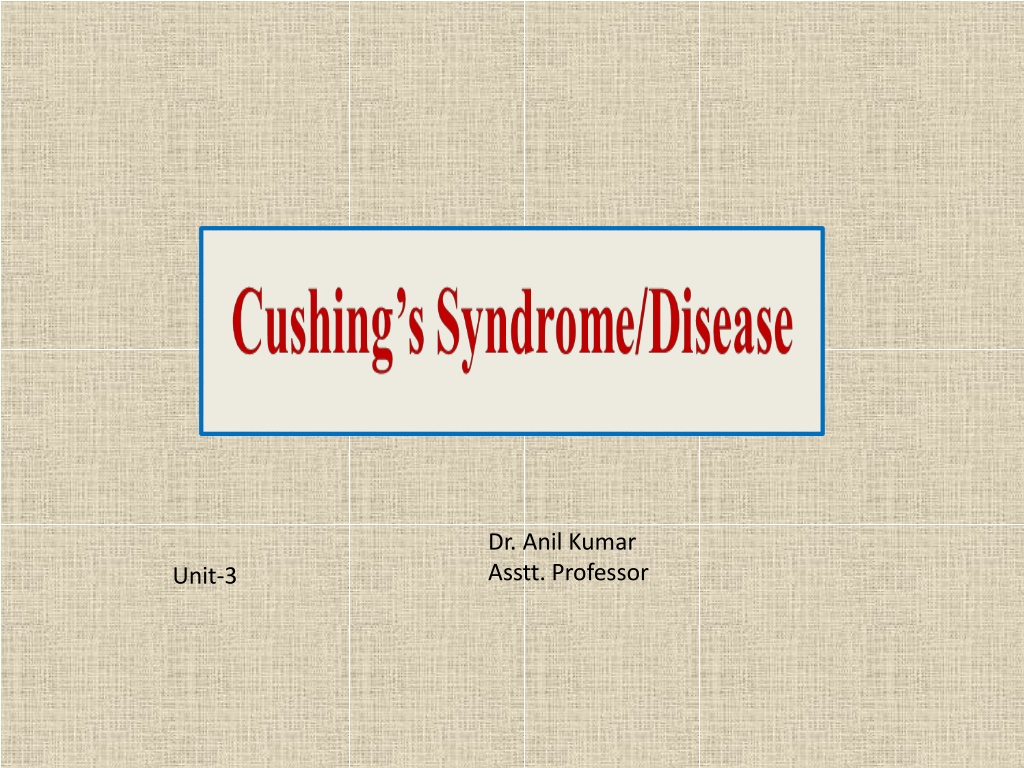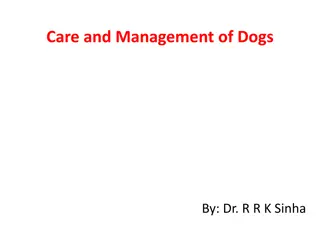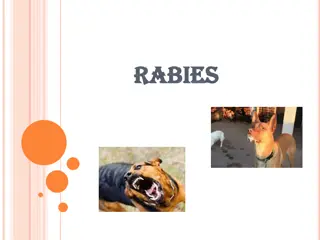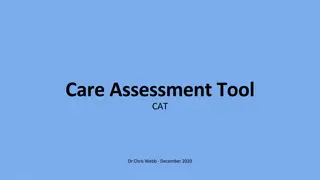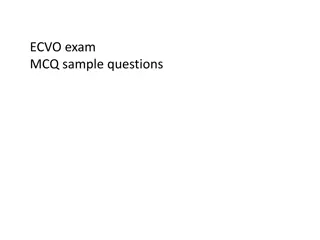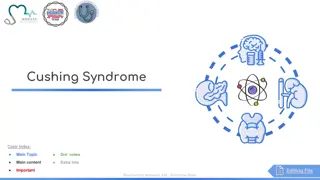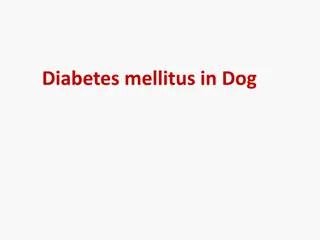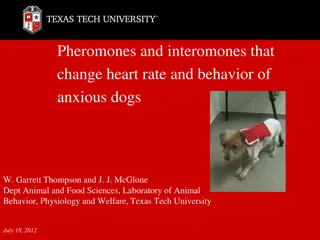Understanding Cushing Disease in Dogs and Cats
The pituitary gland, or "Master Gland," plays a crucial role in hormone regulation in the body. Cushing disease, a common endocrine disorder in middle-aged to older dogs and cats, is often caused by tumors in the pituitary or adrenal glands. Symptoms include increased thirst, appetite, panting, obesity, and skin issues. Breed susceptibility and clinical signs vary between species, with dogs exhibiting certain serum chemistry abnormalities. Early detection and proper management are essential in treating Cushing disease.
Download Presentation

Please find below an Image/Link to download the presentation.
The content on the website is provided AS IS for your information and personal use only. It may not be sold, licensed, or shared on other websites without obtaining consent from the author. Download presentation by click this link. If you encounter any issues during the download, it is possible that the publisher has removed the file from their server.
E N D
Presentation Transcript
Dr. Anil Kumar Asstt. Professor Unit-3
Introduction The pituitary gland (Master Gland) is located near the center and bottom of the brain It produces a number of critical hormones that control many parts of the body, including several other endocrine glands Any cause of elevated cortisol concentrations is known as hyperadrenocorticism. Large numbers of hormones are produced by the pituitary gland, a variety of different conditions can be caused by pituitary disease or tumors.
The specific illness and signs depend on the cause and the area(s) of the pituitary gland that is affected. Cushing disease, or pituitary-dependent hyperadrenocorticism, arises from adenomatous enlargement of the pituitary gland, resulting in excessive ACTH production. A related term, Cushing syndrome, refers to elevated adrenocortical hormones, regardless of cause. The hyperadrenocorticism as well as adrenal-dependent disease latter term includes pituitary-dependent
Etiology Common endocrine disease of middle-aged to older dogs (7 12 years old), but not in other species. The most common cause (85% to 90% of cases) is a tumor in the pituitary gland A tumor in the adrenal glands themselves Iatrogenic hyperadrenocorticism/ Longterm use of corticosteroid drugs can also cause signs of Cushing disease Breed susceptibility: Miniature Poodles, Dachshunds, Boxers, Boston Terriers, and Beagles are at increased risk Large-breed dogs often have adrenal tumors, and there is a distinct predilection in females (3:1). In cats, hyperadrenocorticism is found in middle-aged to older cats, with a slight predilection in females (60%).
Clinical Signs Dogs and Cats: Increased thirst and urination, increased appetite Heat intolerance Lethargy A potbelly, Panting, Obesity Weakness, Thin skin, hair loss, and bruising. .
Rarely, calcinosis cutis develops, a condition in which minerals are deposited in the skin and can appear as small, thickened dots on the abdomen In cats, the most striking dermatologic sign is increased skin fragility; many cats present with self-inflicted cutaneous wounds. Secondary infections (especially respiratory) are also common in cats In dogs, serum chemistry abnormalities associated with hypercortisolemia : increased serum alkaline phosphatase (SAP); {Due to induction of a specific hepatic isoenzyme} increased ALT ( Due to hepatocellular necrosis, glycogen accumulation, and swollen hepatocytes) Hypercholesterolemia (due to steroid stimulation of lipolysis)
Hyperglycemia decreased peripheral tissue utilization through insulin antagonists Decreased BUN Approximately 10% of Cushingoid dogs are diabetic However, in cats with hyperadrenocorticism, almost 80% present with overt diabetes mellitus and insulin resistance. Haemogram: Regeneration (erythrocytosis, nucleated RBCs) and a classic stress leukogram (eosinopenia, lymphopenia, and mature leukocytosis). Most of the dogs have the evidence of urinary tract infection without pyuria (positive proteinuria resulting from glomerulosclerosis. (Due increased gluconeogenesis and culture), bacteriuria, and
In cats, polydipsia and polyuria are a result of concurrent diabetes mellitus, and urine specific gravity is usually high. In dogs, cortisol-induced interference with ADH binding results in hyposthenuria, and central diabetes insipidus may occur as a result of pituitary tumor enlargement. Diagnosis of Cushing Disease Clinical signs Biochemical parameters estimation (eg, high cholesterol, SAP). The urine cortisol to creatinine ratio (UCCR) is a highly sensitive test to differentiate healthy dogs from those with hyperadrenocorticism, but not highly specific because dogs with moderate to severe non-adrenal illness also exhibit increased ratios A stress may cause a falsely increased UCCR.
An increased UCCR should be confirmed with an : ACTH stimulation test, An IV low-dose dexamethasone suppression (LDDS) test, or An oral LDDS test. The LDDS test is the screening test of choice for canine hyperadrenocorticism. An ACTH stimulation test is the test of choice for iatrogenic hyperadrenocorticism. The ACTH stimulation test is used to diagnose various adrenopathic disorders, including endogenous or iatrogenic hyperadrenocorticism and spontaneous hyperadrenocorticism The high-dose dexamethasone suppression (HDDS) test INDICATE adrenal tumors
Measurement of endogenous plasma ACTH concentrations can differentiate between PDH and adrenal tumors by: low to undetectable ACTH concentrations---adrenal tumors normal to increased ACTH concentrations--- Pituitary-dependent Hyperadrenocorticism(PDH) Diagnostic imaging of the pituitary and the adrenal glands Abdominal radiography (all dogs that do not suppress on an HDDS i.e. for tumours) Ultrasonography (adrenal tumors/ adrenal carcinomas to detect metastasis in liver or into the vena cava ) CT or MRI (brain or abdominal cavity to dectect unilateral adrenal enlargement/pituitary macroadenoma/ pituitary microadenoma
Treatment: Medical Surgical ((hypophysectomy)) Radiation therapy Medical Management: Adrenolytic agent mitotane @25 50 mg/kg/day for 7 10 days Monitor for signs of hypoadrenocorticism, such as anorexia, vomiting, and diarrhoea, discontinued the treatment and give glucocorticoids administered. Trilostane, started @ 1-3 mg/kg X2 PO to achieve a decrease in glucocorticoid secretion from the adrenal glands. Pre-trilostane and 3-hour post trilostane cortisol concentrations 138 nmol/L or 62 nmol/L, respectively, were associated with excellent control based on clinical signs
EQUINE CUSHINGS DISEASE INTRODUCTION: This endocrinopathy of horses and ponies with a large number of older animals affected. is the most common All breeds and types of equids can be affected but Morgan horses and ponies appear to be at greater risk. It is characterized by abnormal growth of haircoat, persistent sweating, lethargy/dullness, weight loss, excessive thirst, chronic infections and chronic laminitis. It is exclusively attributed to hyperplasia or adenoma formation in the pars intermedia that appears to be due to loss of hypothalamic innervation of dopaminergic nerve (reduced anti- oxidant defense mechanisms in neural tissue). This leads to over production of pro-opio melanocortin (POMC) peptides.
Pathogenesis: Pro-opio-melanocortin peptides Overall, these conditions contribute to excessive ACTH production, and the enlarged gland makes a mechanical pressure on adjacent tissues, inhibiting function of the pars distalis and pars nervosa. The enlarged pars intermedia can be hormonally active resulting in increased expression of proopiomelanocortin (POMC) peptides which include adrenocorticotropic hormone (ACTH), melanocyte stimulating hormone (MSH), intermediate lobe peptide (CLIP), and beta- endorphin ( -END). corticotropin-like
Clinical Signs: Hirsutism (long curly hair coat): It is characterized by long, shaggy and curly hair coat, particularly found in limbs. Some animals may have matted thick tufts of hair due to persistent sweating (Hyperhidrosis). cases there is prolonged retention of the winter hair coat. Laminitis: All four feet may be laminitic, due to effects of endogenous laminar vasculature. Excessive, curly coat in summer In many cortisol on Chronic laminitis in a horse with PPID
Clinical Signs: Cont---- Polyuria /Polydipsia: Leading to Diabetic conditions might be due to: Increased plasma levels, Decreased hormone (ADH) production, Secondary damage Osmotic diuresis resulting from hyperglycemia. Weight loss, poor muscle tone/weakness particularly of epaxial (topline), lumber and abdominal muscle groups give dip-backed and or pot-bellied appearance. Changes in behaviour and attitude: The affected cases are often lethargic, drowsy or even somnolescent. This might be associated with raised levels of pituitary peptides, endorphins in cerebrospinal fluid (CSF). The reproductive cycles of mares are interrupted or abnormal in duration, and some affected mares even produce milk pregnancy. dull, docile, cortisol anti-diuretic particularly pars nervosa without
Potbelly appearance Fat accumulated on it s neck. Hirsutic Horse Periorbital swelling
Diagnosis: A drawback in the many of indicated tests do not test the pars intermedia cells directly. Based on history and clinical signs: The best indication of PPID is the presence of hirsutism in an aged horse. A complete blood cell count (CBC), biochemical (mild to moderate hyperglycemia, increased hepatic enzymes, cholesterol and tryglycerides )and urine analysis. The cortisol rhythm test The Dexamethasone suppression test (DST) ACTH measurement Thyroid releasing hormone (TRH) test Hyperinsulinemia along with hyperglycemia One new approach is to give Domperidone (dopamine antagonist )
Treatment: The main goal of therapy is to increasing dopaminergic tone in the pars intermedia or decreasing circulating cortisol concentration. Pergolide @0.002 mg/kg PO q 24 h (1 mg per 450 kg). This dose may be slowly increased if the horse becomes refractory to treatment. Anorexia, depression and ataxia are the common side effects and the dose may be reduced in the events of adverse effects. Bromocriptine is also a dopamine agonist but due to its poor bioavailability,it is not commonly used. Cyproheptadine, a serotonin antagonist @ 0.25mg/kg/d in the morning is recommended to treat PPID and also may be used in combination with pergolide. Laminitis is treated with non-steroidal anti-inflammatory drugs (NSAIDs), such as phenylbutazone. Management: Dietary management is of primary importance in all horses with insulin resistance (Hyperglycemia).
Management Cont----- A diet of low soluble carbohydrate-content feed and forage to provide low glycemic response. Affected animals often allowed limited pasture grazing or withheld from it altogether in fresh growth of grasses due to high sugar contents. However, grass hay provides a much lower glycemic response. As a rule, grain and most concentrates should not be fed because of their high carbohydrate levels, which increase the glycemic response. Sometimes, more calories as feeds containing molasses-free beet pulp, corn oil, canola oil, rice bran oil, or rice bran are needed especially for working horses or horses with poor dentition. Many feed manufacturers have developed pelleted complete feeds to stimulate a low glycemic response in geriatric horses. Magnesium (insulin sensitivity) and chromium(Improve glucose uptake and insulin sensitivity) supplementation have been a Vitamin E and C is also dvocated.
Conclusion: PPID is a disorder of pituitary pars intermedia dysfunction and early diagnosis of disease is challenging. It is a lifelong condition, and the prognosis for correction of the disorder is poor. However, it can effectively be treated with a combination of management factors and medications.
References: Dybdal N. (1997). Pituitary pars intermedia dysfunction (equine Cushing s-like disease). In: Robinson NE, editor. Current therapy in equine medicine. 4th edition. Philadelphia: WB Saunders; p. 499 501. Wilson M, Nicholson W, Holscher M, Sherrell BJ, Mount CD, Orth DN. (1982).Proopiomelanocortin peptides in normal pituitary, pituitary tumor and plasma of normal and Cushing s horses. Endocrinology. 110:941 54. Pituitary pars intermedia dysfunction- From Wikipedia. Frank, N. and Tadros, E. M. (2014), Insulin dysregulation. Equine Veterinary Journal, 46: 103 112. doi: 10.1111/evj.1216. Stephen M. Reed; Warwick M. Bayly; Debra C. Sellon (2010). Equine Internal Medicine (3rd ed.). St. Louis, MO: Saunders/Elsevier. ISBN 978-1416056706. Sandy Love. (1993). Equine Cushing s disease .Br. Vet.J.149:139-151. Patrick M. McCue. (2002).Equine Cushing s disease Vet Clin Equine 18:533 543. Siobhan B. McAuliffe. (2014). Disorders of metabolism, nutrition and endocrine diseases. In Knottenbelt and Pascoe s Color Atlas of Diseases and Disorders of the Horse. 2nd Edn. Elsevier Ltd.pp 218-229.
THANKS THANKS
